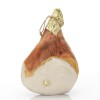The various stages of ham processing
Today I will tell you about the ham production technique used in the Parma area until the early twentieth century.
An art that had its roots in the past and allowed the creation of a healthy and tasty product.
But, above all, easily digestible even by those with stomach problems.
In this regard, history tells us that, in the early 1800s, the Emperor Napoleon Bonaparte (who suffered from ulcers, editor's note) on a visit to the Parma fair tasted a slice of ham and not having been ill, like the as usual, he signed a decree authorizing its export to all territories of the empire.
HOW THE WORK WAS CARRIED OUT IN THE PAST
As I already said in the post dedicated to butchers, pigs were slaughtered in winter.
The slaughter was done in the coldest period of the year because this in itself allowed to block the bacterial activity present in the pork meat.
But to complete the work of eliminating the bacteria, after the pigs' legs had been trimmed to give them the characteristic shape of the ham (phase 1), they were covered with salt (phase 2).
In this way the meat dried as it lost water, that is the element that allowed the bacterial load to continue its activity.
After being salted, the ham was left to rest in the cells for twenty-two days and, subsequently, groomed and cleaned of salt (phase 3).
At this point we moved on to its maturation (phase 4) and it is here that another element enters the scene: the air.
The air continued the activity of the salt which had removed most of the water to originally block the fermentations and the work of the bacteria.
In this way, only the good bacteria remained active, i.e. those that give the ham its characteristic taste.
Once the first phase of the seasoning was completed, the area where the leg was cut, which was not protected by the rind, was covered with sugna, a mixture of pork fat and spices (phase 5).
Finally, to find out if a ham was good, the pointing (or tapping) took place (phase 6).
Through an instrument made of horse bone similar to an awl, called fibula, all the hams were pierced in five different, but pre-established points, and "tasted" with the nose.
The person in charge of this operation, in fact, sniffed the part that had been immersed in the meat and determined the fate of the ham.
This is because if the leg did not pass the olfactory test as there were still traces of fermentation, then it was destined to become a cooked ham.
Curiosity: you must know that horse bone is the only material in the world that has the particularity of retaining the smell of ham for a few seconds and then releasing it just as quickly.
This feature allows you to use the same fibula for several hams consecutively.
All the other materials tested after stabbing some hams remain impregnated with their smell.
And this is a big problem since it would force the taster to constantly change the awl.
For this reason, even today, the fibula is made with horse bone.
CONCLUSION
I hope you enjoyed our short journey to discover the ham production technique used in the past in the Parma area.
I look forward to seeing you in the next post.
Ciao,
Mamma Rosa


